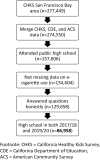Flavored Tobacco Sales Restrictions and Teen E-cigarette Use: Quasi-experimental Evidence From California
- PMID: 35983929
- PMCID: PMC9717361
- DOI: 10.1093/ntr/ntac200
Flavored Tobacco Sales Restrictions and Teen E-cigarette Use: Quasi-experimental Evidence From California
Abstract
Introduction: Flavored tobacco sales restrictions (FTSRs) are implemented to reduce access to flavored tobacco products. We examined the association between seven cities with local FTSRs implemented in 2018/2019 and e-cigarette use among high school students in the California Bay Area.
Aims and methods: We analyzed data from the California Healthy Kids Survey using a difference-in-differences (D-I-D) strategy. We compared pre- and post-policy changes one year after implementation in current and ever e-cigarette use among students attending school in a city with a FTSR (exposed) (n = 20 832) versus without (unexposed) (n = 66 126). Other outcomes included ever marijuana use in an e-cigarette and ease of access to e-cigarettes.
Results: Pre- to post-policy, the adjusted odds of current and ever e-cigarette use did not significantly change among students exposed and unexposed to a FTSR. In the adjusted D-I-D analysis, the odds of current (aOR: 1.25, 95% CI: 0.95, 1.65) and ever e-cigarette use (aOR: 1.06, 95% CI: 0.89, 1.26) did not significantly change by exposure group. However, one year post-implementation, the odds of ease of access to e-cigarettes significantly increased among exposed (aOR: 1.57, 95% CI: 1.27, 1.95) and unexposed students (aOR: 1.54, 95% CI: 1.39, 1.70). Similarly, the odds of ever using marijuana in an e-cigarette significantly increased among exposed (aOR: 1.35, 95% CI: 1.19, 1.53) and unexposed students (aOR: 1.29, 95% CI: 1.20, 1.39).
Conclusions: Local FTSRs in the California Bay Area were not associated with a change in e-cigarette use one year post-implementation. Increased ease of access and marijuana use may be explanatory factors.
Implications: FTSRs were not associated with a decrease in current or ever e-cigarette use among high school students in the California Bay Area one-year post-implementation. Potential explanatory factors are that ease of access to e-cigarettes and using marijuana in an e-cigarette increased. More research is needed to understand the influence of these factors on youth access and behaviors. To address the youth e-cigarette epidemic, a comprehensive approach is needed, including policies, media campaigns, education programs, and cessation tools targeted to youth.
© The Author(s) 2022. Published by Oxford University Press on behalf of the Society for Research on Nicotine and Tobacco. All rights reserved. For permissions, please e-mail: journals.permissions@oup.com.
Figures
References
-
- Surgeon General’s Advisory on E-cigarette Use Among Youth . https://e-cigarettes.surgeongeneral.gov/documents/surgeon-generals-advis.... Accessed June 24, 2021.
-
- Institute for Global Tobacco Control. State of the Evidence: Flavored Tobacco Product Bans or Restrictions . 2020. https://www.drugsandalcohol.ie/32662/1/state_of_the_evidence_-_flavor_ba.... Accessed September 7, 2021. - PMC - PubMed
-
- E-cigarettes: Facts, Stats, and Regulations . 2021. https://truthinitiative.org/research-resources/emerging-tobacco-products.... Accessed on September 7, 2021.
-
- FDA News Release - FDA Commits to Evidence-Based Actions Aimed at Saving Lives and Preventing Future Generations of Smokers . 2021. https://www.fda.gov/news-events/press-announcements/fda-commits-evidence.... Accessed September 7, 2021.


